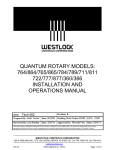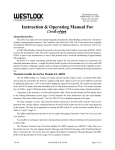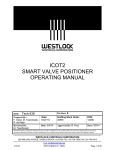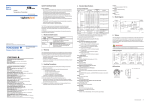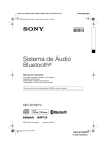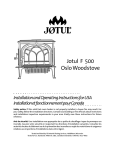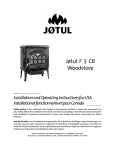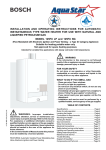Download Westlock Controls Corporation 7644 Specifications
Transcript
Intellis DeviceNet Network Monitor Models 7604, 7644 & 7679 Installation and Operation Manual Revision History Revision 1.0 1 June, 2004 Initial Version Revision 1.1 10 February, 2005 Document was updated to reflect new PCB design, addition of pneumatic section, misc. corrections and changes in IOM format. Revision 1.2 7 August, 2006 Changed note 9 in Class Code 9 of Appendix B Tech-309 1 Introduction Scope of Manual 1-2 Symbols Used in this Document 1-2 About DeviceNet 1-2 Westlock Intellis DeviceNet Module EL-40092 1-3 Module Bit Map Watchdog Timer LED Status Indicators EL-40092 Module Layout Device Specifications Specifications DeviceNet Features EL-40092 Current Consumption Tech-309 1-4 1-4 1-5 1-7 1-7 1-7 1-8 1-8 1-1 1.1 Scope of Manual This manual contains installation, configuration and specification data for the DPAC DeviceNet valve controller. This manual assumes a basic level of familiarity and competence with DeviceNet terminology and technology. Only qualified personnel should install, operate and maintain this equipment. 1.2 Symbols Used in this Document This symbol warns the user of possible danger. Failure to heed this warning may lead to personal injury or death and/or severe damage to equipment. This symbol identifies information about operating the equipment in a particular manner that may damage it or result in a system failure. Failure to heed this warning can lead to total failure of the equipment or any other connected equipment. This symbol draws attention to information that is essential for understanding the operation and/or features of the equipment. 1.3 About DeviceNet DeviceNet is an open network standard originally developed by Allen-Bradley and based on a broadcast oriented, communications protocol - the Controller Area Network (CAN). The CAN protocol was originally developed by BOSCH the European automotive market for replacing expensive, wire harnesses with a low-cost network. In 1995 Allen-Bradley released the protocol to the open DeviceNet Vendors Association (ODVA). ODVA oversees the development of the DeviceNet specification and the conformance testing of DeviceNet products. ODVA is open to any manufacturer or user of this protocol with a worldwide membership of over 250 companies. DeviceNet is a simple networking solution that reduces the cost and time required to install and wire industrial automation devices. A single DeviceNet Intellis System will accommodate up to 63 valves and 1008 discrete I/O points. Although a simple system to Tech-309 1-2 design and implement, DeviceNet has the capability to interconnect complex as well as simple devices to the same network, easily accommodating both analog and discrete I/O. Westlock Controls is a member of ODVA and our DeviceNet products are conformance tested and certified. 1.4 Westlock Intellis DeviceNet Module EL-40092 The EL-40092 module is a 4 input, two output network monitor. Inputs 0 and 1 are internal Hall Effect sensors that are activated by the field of a magnet (south pole). Inputs 2 and 3 are active high/low (activated by pulling the input up to +24V or activated by pulling the input down to ground). The outputs are open drain active low FETs, fused (solid state self resetting) at 0.2A with diode protection to 24Vdc. For current consumption see Table 6, page 1-8. Minimum power supply input voltage is 19Vdc to insure proper solenoid operation. Connection to the network is via DeviceNet specific cable. There are both Round and Flat Media Refer to the Allen-Bradley document “DeviceNet Cable System”’ (Cat. No. DN-6.72) for a detailed treatment of this topic. For data exchange to occur each network monitor connected to the DeviceNet network must be programmed with a unique address, numbered between 0 and 63 and all nodes must be set to the same Baud rate as the scanner. This may be accomplished via setting the DIP switch, S1, on the electronics module. The address and Baud rate may also be set via explicit Messaging if positions 7 and 8 on S1 are set to the “On” position. Refer to Section 3.1, page 3-2 for additional information. It is possible to exchange or add slaves during normal operation without interfering with communications to other nodes. The Westlock Controls Corp. DeviceNet Module, EL-40092, operates as a GROUP 2 Only Slave on a DeviceNet network. The unit supports Explicit Messages and Polled I/O Messages of the Predefined Master/ Slave Connection Set. The device does not support the Explicit Unconnected Message Manager (UCMM). Refer to Section 1.5 Device Specifications, page 1-7, for a summary of features. Tech-309 1-3 1.4.1 Module Bit Map Table 1 I/O TYPE MODULE REFERENCE INPUT 0 Hall Effect Internal Sensor INPUT 1 Hall Effect Internal Sensor INPUT 2 INPUT 3 Active High/Low* Active High/Low* J2-1 (In Hi/Low) to J2-2 (Ground) J2-3 (In Hi/Low) to J2-4 (Ground) BITMAP OF DATA INSTANCE #4 (8-POINT INPUT WITH NO STATUS) ATTRIBUTE #3 (DATA) BYTE 0, BIT 0 Valve Closed (Bottom L.S.) BYTE 0, BIT 1 Valve Open (Top L.S.) BYTE 0 BIT 2 Aux. Input BYTE 0, BIT 3 Aux. Input *Active High/Low indicates that pulling the input pin up to +U or down to ground activates the input. BITMAP OF DATA I/O TYPE MODULE REFERENCE INSTANCE #33 (STATIC OUTPUT) ATTRIBUTE #3 (DATA) OUTPUT 0 Active Low* J4-1 (+24V) to J4-2 (Out) OUTPUT 1 Active Low* J4-3 (+24V) to J4-4 (Out) BYTE 0, BIT 0 “A” Solenoid BYTE 0, BIT 1 “B” Solenoid or Aux. Output *Active Low indicates that when the output is activated it pulls the pin down to GND drawing current through the load from the +24V 1.4.2 Watchdog Timer The DeviceNet Connection Object (Class Code 05) of the DPAC firmware has an integral inactivity/watchdog timer (IWT). The behavior of the IWT is defined by the DeviceNet Specification. There are two types of message connections, Explicit and I/O, each with their own IWT. There are also different configurable attributes that effect device behavior in the event of an IWT timeout. The initial timeout value is the expected_packet_rate attribute multiplied by 4 or by 10 seconds, which ever is greater (Configuring state). All subsequent activations of the IWT use the expected_packet_rate attribute multiplied by 4 as the number of milliseconds to load into the IWT (Established state). The default configuration of the DPAC will cause the outputs of the DPAC to go to the de-energized state when either IWT times out. The IWT attribute for the Explicit message connection is configurable via explicit messaging. There are two values for this attribute supported by the DPAC; Auto Delete (the factory default setting) and Deferred Delete. Refer to Table 2 for definitions of these values and refer to Appendix B for the Device Specification to obtain Class, Instance, Attribute codes for explicit messaging the device. The DeviceNet Discrete Output Point Object (Class Code 09) controls the behavior of the DPAC outputs. There are four attributes that specify the behavior of the device when either a Fault state (IWT timeout) or Idle state (Poll message without data) is entered. The DPAC may be configured to execute the Fault Value, outputs “ON” or “OFF”, or to keep at last value. Refer to Appendix B for the Device Specification for additional information. Tech-309 1-4 Table 2 Value 1 3 Meaning Auto Delete: The Connection Class automatically deletes the Connection if it experiences an IWT timeout. This is the default value for this attribute with respect to Explicit Messaging Connections Deferred Delete: The Connection transitions to the Deferred state if any child connection instances are in the Established state. If no child connection instances are in the Established state the connection is deleted. This value is invalid for I/O Messaging Connections. 1.4.3 LED Status Indicators The LEDs provide information concerning the status of inputs, outputs, the module and/or the network. The LEDs provide visual indication whether any inputs or outputs are active and whether the module or network is in a fault condition. The I/O Status LEDs are intended to indicate the state of the inputs and outputs only. Refer to Table 3, page 1-6, for more information. Tech-309 1-5 Table 3 Module p/n LED Module Status LED 1 Network Status LED 2 EL40092 Closed LS IN_0 LED Open LS IN_1 LED Aux. Input IN_2 LED Aux. Input IN_3 LED Output OUT_0 LED Output OUT_1 LED Tech-309 State Indicates Off Green There is no power applied to the device. Device is operating in a normal condition. The device Needs commissioning due to Flashing Green configuration missing, incomplete or incorrect. Red Unrecoverable fault, device may need replacing. Flashing Red Recoverable fault. Off Not powered/ Not online For a Group 2 Only device: Device is allocated to Green Master Online, not connected. For a Group 2 Only device: Flashing Green Device is not allocated to a Master Failed communication device. The device has detected an error that has rendered it incapable of Red communication on the network (Duplicate MAC ID or Bus-off). One or more I/O connections are in the Time-out Flashing Red state. Input 0, Bottom L.S. Closed: Valve is in the closed position as determined by the triggering of Yellow the Internal Hall Effect sensor by the travel of the trigger mechanism on the shaft assembly. Input 1, Top L.S. Closed: Valve is in the open position as determined by the triggering of the Yellow Internal Hall Effect sensor by the travel of the trigger mechanism on the shaft assembly. Input 2, Active: Dry contact type switch attached Yellow to this input is closed. Input 3, Active: Dry contact type switch attached Yellow to this input is closed. Yellow Output 0. “A” Solenoid is energized. Yellow Output 1. “B” Solenoid is energized. 1-6 1.4.4 Module Layout J1 Figure 1- EL-40092 1.5 Device Specifications 1.5.1 Specifications Table 4 Round Physical Media Flat Physical Media Supported Topology Maximum Trunk Distance Maximum Nodes/Network Maximum I/O Points/Network Typical Current Consumption/Network Monitor Host System’s Interface Communications Method Error Checking Redundancy Valve Specific Diagnostics Tech-309 Shielded 2 twisted pairs for communication and power Unshielded 4 parallel conductors for communications and power Trunk and drop Round Media: 500m (1640’) @ 125 kbd Flat Media: 420m (1378’) @ 125 kbd 64, one being the master 378, 4 inputs and 2 outputs/DPAC 75 mA with single Falcon NI solenoid energized 80 mA with single Falcon XP solenoid energized Allen-Bradley, Omron, Emerson and many others Group 2 only slave CRC No No 1-7 1.5.2 DeviceNet Features Table 5 DeviceNet Features Device Type Explicit Peer to Peer Messaging I/O Peer to Peer Messaging Configuration Consistency Value Faulted Node Recovery Baud Rates Master/Scanner I/O Slave Messaging • Bit Strobe • Polling • Cyclic • Change of State (COS) Generic No No No No 125K, 250K, 500K Yes No Yes No No 1.5.3 Current Consumption Table 6 Inputs Active Outputs Active Current Draw1 0 0 50mA 4 0 62mA 4 1 80mA 4 2 100mA 4 1 85mA(XP) 4 2 110mA(XP) 1 All current values acquired using a non-incendive solenoid except where noted by an XP (explosion Tech-309 1-8 2 Installation Instructions Mounting 2-2 Pneumatic Connections 2-3 Tubing and Fittings Porting Maintenance 2-3 2-4 2-4 Switch Adjustment 2-5 Wiring Instructions 2-6 Wiring Diagram DPAC Connector Pin-out Diagrams 2-7 2-8 DeviceNet Cabling Information 2-9 DeviceNet Supported Topologies 2-9 Tech-309 2-1 IMPORTANT: If the valve monitor is already in the field mounted on an actuator and valve, please follow the field wiring instructions in Section 2.4. Confirm that the area is known to be non-hazardous before opening the cover of a network monitor and making or breaking any electrical connections. 2.1 Mounting For steps 1-3 refer to Figure 2 below. 1. Attach the proper mounting bracket and adapter (if required) to the valve monitor housing with the hardware provided. 2. Operate the actuator to full closed position. 3. Attach the valve monitor and mounting bracket to the actuator. 4. Note the position of the actuator/valve and confirm the Beacon position is properly aligned, as shown in Figure 3 below while replacing the cover. Figure 2 Tech-309 2-2 Figure 3 2.2 Pneumatic Connections Personal injury and/or property damage may occur from loss of process control if the supply medium is not clean, dry oil-free air or non-corrosive gas. Instrument quality air that meets the requirements of ISA Standard S7.3-1975 is recommended for use with pneumatic equipment in process control environments. Westlock Controls recommends the use of a 20 micron filter with all Falcon solenoids. 2.2.1 Tubing and Fittings The use of copper, stainless steel, nylon or polyethylene tube is recommended for piping up air circuits and equipment. As a general rule, pipe threaded fittings should not be assembled to a specific torque because the torque required for a reliable joint varies with thread quality, port and fitting materials, sealant used, and other factors. The suggested method of assembling pipe threaded connections is to assemble them finger tight and then wrench tighten further to a specified number of turns from finger tight. The assembly procedure given below is for reference only; the fitting should not be over tightened for this will lead to distortion and most likely, complete valve failure. 1. Inspect port and connectors to ensure that the threads on both are free of dirt, burrs and excessive nicks. Tech-309 2-3 2. Apply sealant/lubricant or Teflon tape to the male pipe threads. With any sealant tape, the first one or two threads should be left uncovered to avoid system contamination. 3. Screw the connector into the port to the finger tight position. 4. Wrench tighten the connector approximately 1 - 2 turns (to seal) from finger tight. Again this is only reference - the fitting should NOT be over tightened. 2.2.2 Porting Figure 4 2.2.3 Maintenance Routine maintenance is usually confined to the periodic replenishment of Dow Corning III lubricant or equivalent to spool and spring. Tech-309 2-4 2.3 Switch Adjustment Switches are factory set. If you need to adjust switches for any reason follow instructions below. For steps 1-8 refer to Figures 1 and 5. 1. Refer to Figure 1 and note the approximate locations of the Open and Close targets on the DPAC module. 2. With the valve in the closed position, lift bottom cam of the Close sensor trigger. 3. Turn cam until face of trigger is perpendicular to the target and sensor is activated as evidenced by the lighting of the corresponding module LED. 4. Release the cam and the spring will push cam back onto the splined shaft. 5. Operate the actuator to the opened position. 6. Push down the top cam of the Open sensor trigger. 7. Turn cam until face of trigger is perpendicular to the target and sensor is activated as evidenced by the lighting of the corresponding module LED. 8. Operate actuator from one extreme to the other several times to check Limit Sensor operation. Figure 5 Tech-309 2-5 2.4 Wiring Instructions All wiring must be in accordance with National Electrical Code (ANSI-NFPA-70) for the appropriate area classifications. All wiring must be in accordance with National Electrical Code (ANSINFPA-70) for area classifications. The valve monitors are approved as nonincendive for Class I, Division 2, Groups A,B,C and D; dust-ignition proof for Class II/III, Division 1, Groups E,F and G hazardous (classified) locations; indoor/outdoor (NEMA type 4, 4X). Always check the nameplate to make sure the agency approval ratings coincide with the application. The proper wiring diagram for your unit is shown on the inside of the enclosure cover. 1. Wiring options for 7604, 7644 and 7679 are shown in Figures 6 and 7 below. 2. Replace the electronics housing cover or junction housing cover. 3. Unit is now ready for automatic operation. If any assistance is required, please call Westlock Controls at (201) 794-7650. Tech-309 2-6 Tech-309 2-7 2.4.1 DPAC Connector Pin-out Diagrams Tech-309 2-8 2.5 DeviceNet Cabling Information Correct termination of the trunk and total trunk and drop limits for the baud rate the network is to run at must be observed or unreliable operation may result. Table 7 Data Rate 125 kbd 250 kbd 500 kbd Maximum Distance Flat Cable Thick Cable 420m (1378’) 500m (1640’) 200m (656’) 250m (820’) 75m (246’) 100m (328’) Med. & Thin Cable 100m (328’) 100m (328”) 100m (328’) Table 8 Data Rate 125 kbd 250 kbd 500 kbd Maximum Cumulative Drop Length 156m (512’) 78m (236’) 39m (128’) 2.6 DeviceNet Supported Topologies Figure 14 Tech-309 2-9 3 DPAC Configuration Communication Settings Baud Rate and Address via the DIP Switch Baud Rate and Address via the Bus Tech-309 3-2 3-2 3-4 3-1 3.1 Communication Settings For the appropriate DIP switch settings for the address and baud rate of the DPAC refer to Figure 15 and Tables 9 and 10. Figure 15 3.1.1 Baud Rate and Address via the DIP Switch Table 9 Switch S1 SW8 SW7 OFF OFF OFF ON ON OFF ON ON Tech-309 Baud Rate Returned Value 125 Kbd 250 Kbd 500 Kbd Default 125 Kbd or last value set via bus (see Section 3.1.2) 0x00 0x01 0x02 0x00 (default) or 0x01 to 0x02 if set 3-2 Table 10-a Switch S1 MAC ID Returned Value 0 1 2 3 4 5 6 7 8 9 10 11 12 13 14 15 16 17 18 19 20 21 22 23 24 25 26 27 28 29 30 31 31 32 33 34 35 36 37 38 39 40 41 42 43 44 0x00 0x01 0x02 0x03 0x04 0x05 0x06 0x07 0x08 0x09 0x0A 0x0B 0x0C 0x0D 0x0E 0x0F 0x10 0x11 0x12 0x13 0x14 0x15 0x16 0x17 0x18 0x19 0x1A 0x1B 0x1C 0x1D 0x1E 0x1F 0x1F 0x20 0x21 0x22 0x23 0x24 0x25 0x26 0x27 0x28 0x29 0x2A 0x2B 0x2C SW6 SW5 SW4 SW3 SW2 SW1 OFF OFF OFF OFF OFF OFF OFF OFF OFF OFF OFF OFF OFF OFF OFF OFF OFF OFF OFF OFF OFF OFF OFF OFF OFF OFF OFF OFF OFF OFF OFF OFF OFF ON ON ON ON ON ON ON ON ON ON ON ON ON OFF OFF OFF OFF OFF OFF OFF OFF OFF OFF OFF OFF OFF OFF OFF OFF ON ON ON ON ON ON ON ON ON ON ON ON ON ON ON ON ON OFF OFF OFF OFF OFF OFF OFF OFF OFF OFF OFF OFF OFF Tech-309 OFF OFF OFF OFF OFF OFF OFF OFF ON ON ON ON ON ON ON ON OFF OFF OFF OFF OFF OFF OFF OFF ON ON ON ON ON ON ON ON ON OFF OFF OFF OFF OFF OFF OFF OFF ON ON ON ON ON OFF OFF OFF OFF ON ON ON ON OFF OFF OFF OFF ON ON ON ON OFF OFF OFF OFF ON ON ON ON OFF OFF OFF OFF ON ON ON ON ON OFF OFF OFF OFF ON ON ON ON OFF OFF OFF OFF ON OFF OFF ON ON OFF OFF ON ON OFF OFF ON ON OFF OFF ON ON OFF OFF ON ON OFF OFF ON ON OFF OFF ON ON OFF OFF ON ON ON OFF OFF ON ON OFF OFF ON ON OFF OFF ON ON OFF OFF ON OFF ON OFF ON OFF ON OFF ON OFF ON OFF ON OFF ON OFF ON OFF ON OFF ON OFF ON OFF ON OFF ON OFF ON OFF ON ON OFF ON OFF ON OFF ON OFF ON OFF ON OFF ON OFF 3-3 Table 10-b Switch S1 MAC ID Returned Value 45 46 47 48 49 50 51 52 53 54 55 56 57 58 59 60 61 62 63 0x2D 0x2E 0x2F 0x30 0x31 0x32 0x33 0x34 0x35 0x36 0x37 0x38 0x39 0x3A 0x3B 0x3C 0x3D 0x3E 0x3F SW6 SW5 SW4 SW3 SW2 SW1 ON ON ON ON ON ON ON ON ON ON ON ON ON ON ON ON ON ON ON OFF OFF OFF ON ON ON ON ON ON ON ON ON ON ON ON ON ON ON ON ON ON ON OFF OFF OFF OFF OFF OFF OFF OFF ON ON ON ON ON ON ON ON ON ON ON OFF OFF OFF OFF ON ON ON ON OFF OFF OFF OFF ON ON ON ON OFF ON ON OFF OFF ON ON OFF OFF ON ON OFF OFF ON ON OFF OFF ON ON ON OFF ON OFF ON OFF ON OFF ON OFF ON OFF ON OFF ON OFF ON OFF ON 3.1.2 Baud Rate and Address via the Bus Setting S1 positions 7 & 8 to ON will allow the address and the baud rate of the DPAC to be set via explicit messaging over the bus. Once the values for the specific attributes have been set the DPAC must have the power cycled for the new settings to be loaded from the devices RAM and become operable. Refer to DeviceNet Object, Class Code 03 in Appendix B for the explicit messaging codes. When changing the baud rate of the DPAC, once the power to the device has been cycled the master will need to be set to that baud rate to enable communication with the DPAC. Tech-309 3-4 Appendix A Contact Information USA Westlock Controls Corp. 280 Midland Ave. Saddle Brook, NJ 07663 Phone: (201) 794-7650 • Fax: (201) 794-0913 Email: [email protected] Internet: http://www.westlockcontrols.com Europe Westlock Controls UK Chapman Way, Tunbridge Wells Kent, England TN23EF Phone: 011-441-892-519046 • Fax: 011-441-892-516279 South America Westlock Equipmentos De Controles Ltda. Rua, Sao Paulo 291 Alphaville, Barueri Sao Paulo, CEP 06465-130 Phone: 011-55-11-7291-0930 • Fax: 011-55-11-7291-0931 Tech-309 -1- Appendix B Westlock Controls Corporation DeviceNet DN-WLCIO Device Specifications Publication # 07241992 Date 10/09/2000 Revision # 1.01 Board Revision Firmware Revision Rev 1.0 1.01 Tech-309 Date 5/18/1999 10/09/2000 02 1.02 #02061953 Note(s) Original Change format of tables -1- Device Profile The DN-WLCIO is the General Purpose Discrete I/O Device (Profile Number 7) Objects Present in Device Object name(class type) Identity (01) Message Router (02) DeviceNet (03) Connection (05) Assembly (04) Discrete Input Point (08) Discrete Output Point (09) Optional/Required Required Required Required Required Required Required Required # of Instances 1 1 1 2 (one I/O, one Explicit ) 2 (instance #4 and #33) 8 4 Objects That Effect Behavior Object Identity Message Router DeviceNet Connection Assembly #4 Assembly #33 Discrete Input Point Discrete Output Point Effect on Behavior Supports the Reset Service No Effect Configures Port Attributes Establishes the number of connections Defines I/O data format Defines I/O data format No effect Executes Fault & Idle Actions Object Interfaces Object Identity Message Router DeviceNet Connection Assembly Instance #4 Assembly Instance #33 Discrete Input Discrete Output Tech-309 Interface Message Router Explicit Message Connection Instance Message Router Message Router I/O Connection or Message Router I/O Connection or Message Router Assembly Object or Message Router Assembly Object or Message Router -2- Identity Object Class Code: 01(0x01) Class=1, Instance=0, Attribute=1,2,6,7 Identity Object Class Attributes Attribute Access ID Rule 1 Get 2 Get 6 Get 7 Get Common Services - (Class) Service Service Name Code (Hex) 0x0E Get_Attribute_Single Name Data Type Revision Max Object Instance Max Class Identifier Max Instance Attribute Description of service Returns the contents of the specified attribute Class=1, Instance=1, Identity Object Instance Attributes Attribute Access Name ID Rule 1 Get Vendor 2 Get Device Type 3 Get Product Code 4 Get Revision Major Revision Minor Revision 5 Get Status 6 Get Serial Number 7 Get Product Name Length Name 8 Get State 9 Get CCV 10 Not Implemented Heartbeat Common Services - (Instance) Service Service Name Code (Hex) 0x05 Reset 0x0E Get_Attribute_Single UINT UINT UINT UINT Value Hex 0x0001 0x0001 0x0007 0x0009 Attribute=1,2,3,4,5,6,7,8,9,10 Data Type Value UINT UINT UINT STRUCT USINT USINT WORD UDINT STRUCT USINT STRING[5] USINT UINT USINT 0x00F4 0x0007 0x000B 0x01,0x02 0x01 0x02 0x0000 0x02061953* 5,"WLCIO" 0x05 WLCIO [0..5] 0xXXXX Description of Service Depend on parameter, emulate reset type 0 or 1 Returns the contents of the specified attribute * -- Base Serial Number Tech-309 -3- Message Router Object Class Code: 02(0x02) Message Router Object Class Attributes Class Implementation is based on class revision 0x0001. Attributes are not supported. Common Services - (Class) Services are not supported. Message Router Object Instance Attributes Attributes are not supported. Common Services - (Instance) Services are not supported. Tech-309 -4- DeviceNet Object 03(0x03) Class Code: Class=3, Instance=0, Attribute=1 DeviceNet Object Class Attributes Attribute Access Name ID Rule 1 Get Revision Common Services - (Class) Service Service Name Code 0x0E Get_Attribute_Single Data Type UINT Value 0x0002 Description of service Returns the contents of the specified attribute Class=3, Instance=1, Attribute=1,2,3,4,5,6,7,8,9 DeviceNet Object Instance Attributes Attribute Access Name Data Value ID Rule Type 1 Get/Set MACID (Node Address) USINT 0x00 to 0x3F * 2 Get/Set Baud Rate USINT 0x00 to 0x02 ** 3 Get/Set BOI (Bus-Off Interrupt) BOOL 0x00 or 0x01 4 Get/Set Bus-Off Counter USINT 0x00 0xXX,0xXX STRUCT 5 Get Allocation Information Allocation Byte BYTE Choice Byte 0x00-0x3F, 0xFF Master MacID USINT 6 Get MAC ID Switch Changed BOOL 0x00=No Change (since last power-up/reset) 0x01=Changed 7 Get Baudrate Switch Changed BOOL 0x00=No change (since last power-up/reset) 0x01=Changed 8 9 Get Get MAC ID Switch Value Baudrate Switch Value Common Services - (Instance) Service Service Name Code (Hex) 0x0E Get_Attribute_Single 0x10 Set_Attribute_Single 0x4B Allocate_Master/Slave 0x4C Release_Master/Slave USINT USINT 0x00 to 0x3F *** 0x00 to 0x02 **** Description of service Returns the contents of the specified attribute Modifies the contents of the specified attribute Request the use of the Predefined M/S Connection Set Deallocate the Predefined M/S Connection Set * MACID is settable through DeviceNet, if switch S1 positions 7 and 8 are both in the ON position. If switch S1 positions 7 and 8 are both ON then the value returned will be switch S1 positions 1-6 or the last value set. If switch S1 positions 7 and 8 are not both ON then, the value returned will be switch S1 positions 1-6 Tech-309 -5- ** Baud Rate is settable through DeviceNet only if switch S1 positions 7 and 8 are both in the ON position. See Table below. Switch S1 Returned Value Speed Sw8 Sw7 OFF OFF 0x00 125 kbits OFF ON 0x01 250 kbits ON OFF 0x02 500 kbits ON ON 0x00 (default) Default 125 kbits, or 0x01 to 0x02 or last set via Set_Attribute_Single *** MACID Switch Value returned will be switch S1 positions 1..6 OFF means logic 0) MSB Switch S1 LSB Sw6 Sw5 Sw4 Sw3 Sw2 Sw1 OFF OFF OFF OFF OFF OFF OFF OFF OFF OFF OFF ON OFF OFF OFF OFF ON OFF … … … … … … ON ON ON ON ON OFF ON ON ON ON ON ON (ON means logic 1, MacID 0 (0x00 Hex) 1 (0x01 Hex) 2 (0x02 Hex) … 62 (0x3E Hex) 63 (0x3F Hex) **** Baud Rate Switch Value returned will be switch S1 positions 7,8 Switch S1 Returned Value Speed Sw8 Sw7 OFF OFF 0x00 125 kbits OFF ON 0x01 250 kbits ON OFF 0x02 500 kbits ON ON Default 0x00 Default 125 kbits, Tech-309 -6- Assembly Object 04(0x04) Class Code: Assembly Object Class Attributes Implementation is based on the Static Assembly model. Class Implementation is based on class revision 0x0002. Attributes are not supported. Common Services - (Class) Services are not supported. There are two static instances of the Assembly Object in the device. Instance #4 is assigned to the device inputs. Instance #32 or #33 is assigned to the device outputs. Instance #32 is used when the device has 2 outputs or less, Instance #33 is used when the device has 4 outputs. The tables below show the attributes and the predefined values where applicable. Tech-309 -7- Class=4, Instance=4, Attribute=3 Assembly Object Instance #4 Attributes (Instance #4 is type: 8 point with No Status Bit) Attribute ID 3 Access Rule Get Name Data Type Data Common Services - (Instance #4) Service Service Name Code (Hex) 0x0E Get_Attribute_Single ARRAY of one BYTE Value Hex 0x00 to 0xFF BBBBBBBB * binary Description of service Returns the contents of the specified attribute * Format of Assembly Object, Instance #4 (8-point Input with No Status ), Attribute #3 (Data) Byte Number 0 7 DI 8 6 DI 7 5 DI 6 Bit Number 4 3 DI 5 DI 4 2 DI 3 1 DI 2 0 DI 1 Mapping of Assembly Object, Instance #4 (8-point Input with No Status), Attribute #3 (Data) Bit Name DI 1 DI 2 DI 3 DI 4 DI 5 DI 6 DI 7 DI 8 Tech-309 Class ClassName Discrete Input Point Discrete Input Point Discrete Input Point Discrete Input Point Discrete Input Point Discrete Input Point Discrete Input Point Discrete Input Point Number 8 8 8 8 8 8 8 8 Instance Number 1 2 3 4 5 6 7 8 Attribute Name Number Value 3 Value 3 Value 3 Value 3 Value 3 Value 3 Value 3 Value 3 -8- Class=4, Instance=32, Attribute=3 Assembly Object Instance #32 Attributes (Instance #32 is type: 2-Point Output, and is used only when the device has 2 outputs or less. See instance #33 for 4 output devices.) Attribute Access Name ID Rule 3 Get/Set Data Common Services - (Instance #32) Service Service Name Code (Hex) 0x10 Set_Attribute_Single 0x0E Get_Attribute_Single Data Type Value Hex 0x00 to 0x03 ARRAY of one BYTE 000000xx * binary Description of service Modifies the contents of the specified attribute Returns the contents of the specified attribute * Format of Assembly Object, Instance #32 (2-Point Output), Attribute #3 (Data) Byte Number 0 Bit Number 7 0 6 0 5 0 4 0 3 0 2 0 1 DO 2 0 DO 1 Mapping of Assembly Object, Instance #32 (Static Outputs), Attribute #3 (Data), (See Class 09, Discrete Output Point Object) Bit Name DO 1 DO 2 Tech-309 Class Name Discrete Output Point Discrete Output Point Number 9 9 Instance Number 1 2 Attribute Name Number Value 3 Value 3 -9- Class=4, Instance=33, Attribute=3 Assembly Object Instance #33 Attributes (Instance #33 is type: 4-Point Output, and is used only when the device has 4 outputs. See instance #32 for devices with 2 outputs.) Attribute Access Name ID Rule 3 Get/Set Data Common Services - (Instance #33) Service Service Name Code (Hex) 0x10 Set_Attribute_Single 0x0E Get_Attribute_Single Data Type Value Hex 0x00 to 0x0F ARRAY of one BYTE 0000xxxx * binary Description of service Modifies the contents of the specified attribute Returns the contents of the specified attribute * Format of Assembly Object, Instance #33 (4-Point Output), Attribute #3 (Data) Byte Number 0 Bit Number 7 0 6 0 5 0 4 0 3 DO4 2 DO3 1 DO 2 0 DO 1 Mapping of Assembly Object, Instance #33 (Static Outputs), Attribute #3 (Data)), (See Class 09, Discrete Output Point Object) Bit Name DO 1 DO 2 DO 3 DO 4 Tech-309 Class Name Discrete Output Point Discrete Output Point Discrete Output Point Discrete Output Point Number 9 9 9 9 Instance Number 1 2 3 4 Attribute Name Number Value 3 Value 3 Value 3 Value 3 - 10 - Connection Object 05(0x05) Class Code: Connection Object Class Attributes Implementation is based on revision 01 , Attributes are not supported Common Services - (Class) Services are not supported There are two instances of the Connection Object in the device. Instance #1 is assigned to the explicit messaging connection. Instance #2 is assigned to the Polled I/O connection. The tables below show the attributes and the predefined values where applicable. Tech-309 - 11 - Class=5, Instance=1, Attribute=1-17 Connection Object Instance #1 Attributes (Explicit Message Connection – Instance #1) Attr. Access Name ID Rule 1 Get State 2 Get instance_type 3 Get transportClass_trigger 4 Get produced_connection_id Data Type USINT USINT BYTE UINT 5 Get consumed_connection_id UINT 6 Get initial_comm_characteristics USINT 7 8 9 10 11 12 Get Get Get/Set N/A N/A Get/Set produced_connection_size consumed_connection_size expected_packet_rate N/A N/A watchdog_timeout_action UINT UINT UINT N/A N/A USINT 13 14 Get Get produced_conn_path_length produced_connection_path 15 16 Get Get consumed_conn_path_length consumed_connection_path 17 Not Supp. UINT Array USINT UINT Array USINT UINT Production_inhibit_timer Common Services - (Instance #1 ) Service Service Name Code (Hex) 0x0E Get_Attribute_Single 0x10 Set_Attribute_Single 0x05 Reset Tech-309 Value 0x00 0x03 or 0x05 0x00 (0 is explicit) 0x83 (server class3) 10x xxxx x011 binary x xxxx x source –slave MacID 10x xxxx x100 binary x xxxx x destination-slave MacID 0x21 (0x20 - Produce Group2 Msg.) (0x01 - Consume Group 2 Msg.) 0x0007 (not fragmented Msg.) 0x0007 (not fragmented Msg.) Application Dependent Not Used Not Used 0x01 (Auto Delete- default) 0x03 (Deferred Delete ) 0x0000 (default) <NULL> (always empty for explicit) 0x0000 (default) <NULL> (always empty for explicit) (Server devices do not use this timer) Description of service Returns the contents of the specified attribute Modifies the contents of the specified attribute Reset Inactivity/Watchdog Timer, if connection is in “deferred delete” state changes to “established” state. - 12 - Class=5, Instance=2, Attribute=1-17 Connection Object Instance #2 Attributes (Poll I/O connection - Instance #2) Attr. Access Name ID Rule 1 Get State 2 Get instance_type 3 Get transportClass_trigger 4 Get produced_connection_id Data Type USINT USINT BYTE UINT 5 Get consumed_connection_id UINT 6 Get initial_comm_characteristics USINT 7 8 9 10 11 12 13 14 Get Get Get/Set N/A N/A Get Get Get produced_connection_size consumed_connection_size expected_packet_rate N/A N/A watchdog_timeout_action produced_conn_path_length produced_connection_path UINT UINT UINT N/A N/A USINT UINT STRUCT of USINT USINT USINT USINT USINT USINT UINT STRUCT of USINT USINT USINT USINT USINT USINT UINT 15 16 17 Get Get Not Supp. segment type . format value(logical.classID.8bit) segment type .format value(logical.instanceId.8bit) segment type . format value(logical.attributeId.8bit) consumed_conn_path_length consumed_connection_path segment type . format value(logical.classID.8bit) segment type .format value(logical.instanceId.8bit) segment type . format value(logical.attributeId.8bit) Production_inhibit_timer Common Services - (Instance #2) Service Code (Hex) Service Name 0x0E Get_Attribute_Single 0x10 Set_Attribute_Single 0x05 Reset Tech-309 Value 0x01 0x03 or 0x04 0x01 (1 is poll I/O) 0x82 (server class2) 011 11xx xxxx binary xx xxxx source -slave MacID 10x xxxx x101 binary x xxxx x destination-slave MacID 0x01 (0x00 - Produce Group1 Msg.) (0x01 – Consume Group 2 Msg.) 0x0001 0x0001 Application Dependent Not Used Not Used 0x00 (Time Out- default for I/O) 0x0006 0x20.0x04.0x24.0x04.0x30.0x03 fields---------explaination----------0x20 logical.classID.8bit address 0x04 (Class 4 - Assembly) 0x24 logical.instanceID.8bit addr 0x04 (Instance #4 - 8 Inputs) 0x30 logical.attributeID.8bit addr 0x03 (Attribute 3 - Data) 0x0006 0x20.0x04.0x24.0x21.0x30.0x03 fields---------explaination----------0x20 logical.classID.8bit address 0x04 (Class 4 - Assembly) 0x24 logical.instanceID.8bit addr 0x21 (Instance #33 - 4 Outputs) 0x30 logical.attributeID.8bit addr 0x03 (Attribute 3 - Data) (Server devices do not use this timer) Description of service Returns the contents of the specified attribute Modifies the contents of the specified attribute Reset Inactivity/Watchdog Timer, if connection is in “Timed Out” state changes to “Established” state. - 13 - Discrete Input Point Object Class Code: 08(0x08) Class=8, Instance=0, Attribute=1,2,6,7 Discrete Input Point Object Class Attributes Attribute Access Name ID Rule 1 Get Revision 2 Get Max Instance 6 Get Max ID of Class Attr. 7 Get Max ID of Instance Attr. Common Services - (Class) Service Service Name Code (Hex) 0x0E Get_Attribute_Single Data Type UINT UINT UINT UINT Description Value Revision of this object Max. instance created Last attribute ID of Class Last attribute ID of Instance 0x0002 0x0008 0x0007 0x0003 Description of service Returns the contents of the specified attribute Class=8, Instance=1,2,3,4,5,6,7,8, Attribute=3 Discrete Input Point Object Instance #1 to Instance #8 Attributes Attribute Access Name Data ID Rule Type 3 Get Value BOOL Description Value Input Point Value (Instance=1, DI 1) (Instance=2, DI 2) (Instance=3, DI 3) (Instance=4, DI 4) (Instance=5, DI 5) (Instance=6, DI 6) (Instance=7, DI 7) (Instance=8, DI 8) 0=Off 1=On Common Services - (Instance #1 to Instance #8) Service Service Name Description of service Code (Hex) 0x0E Get_Attribute_Single Returns the contents of the specified attribute Tech-309 - 14 - Discrete Output Point Object 09(0x0A) Class Code: Class=9, Instance=0, Attribute=2 Discrete Output Point Object Class Attributes Attribute Access Name Data ID Rule Type 2 Get Max Instance UINT Common Services - (Class) Service Service Name Code (Hex) 0x0E Get_Attribute_Single Description Value Max. instance created 0x0004 Description of service Returns the contents of the specified attribute Class=9, Instance=1,2,3,4, Attribute=3,5,7,8,10 Discrete Output Point Object Instance #1 to Instance #4 Attributes Attr Access Name Data Description ID Rule Type 3 Get/Set Value BOOL Output Value during normal operation (Instance=1, DO 1) (Instance=2, DO 2) (Instance=3, DO 3) (Instance=4, DO 4) 5 9 Get/Set Fault BOOL Action taken on Output upon Action entering recoverable Fault state 6 9 Get/Set Fault BOOL Fault value (used when Attribute 5=0) Value 7 9 Get/Set Idle BOOL Action taken on Output upon Action entering Idle state 8 9 Get/Set Idle BOOL Idle value Value (used when Attribute 7=0) 9 10 Get/Set Flash BOOL Flash Output at periodic rate when output state is “ON” Value 0=Off 1=On 0=Change to Fault Value 1=Keep at Last Value (not used) 0=Turn Output Off 1=Turn Output On (not used) 0=Change to Idle Value 1=Keep at Last Value (not used) 0=Turn Output Off 1=Turn Output On (not used) 0=Do not Flash Output 1=Flash Output (not used) Common Services - (Instance #1 to Instance #4) Service Service Name Description of service Code (Hex) 0x10 Set_Attribute_Single Modifies the contents of the specified attribute 0x0E Get_Attribute_Single Returns the contents of the specified attribute 9 The Default Attributes Values as shown are implemented but are not visible or changeable, this is required for proper behavior of all instances of that class. Tech-309 - 15 -







































